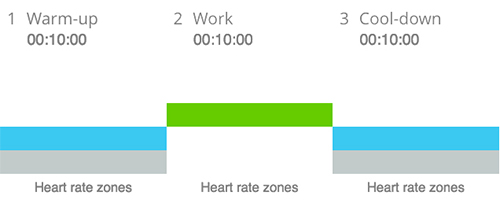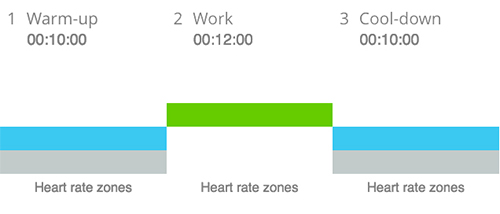Before we take a closer look at interval training, let’s first define what an interval is. According to the internet, an interval is an intervening period. This may mean the time of work, or the time of rest, distance or active recovery.
Interval training is composed of hard work phases and easier rest phases, but how do you know what is hard and what is easy? One way to determine your effort level is heart rate monitoring.
Here USAT Coach of the Year Mike Ricci from D3 Multisport explains how to introduce intervals into your training and how to safely increase the load each week.
Before starting interval training
To successfully use a heart rate monitor in your interval training, you’ll need to find out your maximum heart rate and personal heart rate training zones. The most accurate way to do this is to determine your max HR in a laboratory but if that’s not viable, you can use one of these two field tests to determine your heart rate zones.
Field test for beginners
If you are a complete beginner, go to a flat path or track and run for about 30 minutes at conversational pace. This doesn’t mean you could have a conversation with one word answers, but more in complete sentences. Watch your heart rate and see where it settles for the 30 minutes.
You aren’t trying to run a certain pace, but run at an ‘effort’ that allows you to hold a conversation for the entire time. The number you see on your heart rate monitor would be within your ‘zone 2 heart rate’ or what I like to call your ‘all day effort’.
Field test for experienced runners
If you are an experienced runner and have been running for a year or more, then we’ll give you a thirty minute test to see your lactate threshold. You can use a 5K or 10K for this test, or you can choose to run as fast and as long as you can for thirty minutes. If I had my choice, I’d rather jump into a race and try to race some others and push myself naturally vs. trying to beat myself up for 30 minutes on a solo run.
The average of your heart rate for the 5K or the last 25–30 minutes of the 10K, would be around your LT or lactate threshold. The estimated LT that you get with this field test should be near the boundary between zone 4 or zone 5, either above or below depending on how fit you are.
Interval Training For Beginners: A 12-Week Running Workout Plan
Now that you know your heart rate zones, you can follow this 12-week workout plan to introduce interval training to your training and complement your running plan. For beginners, the following set of intervals would be your progression over 12 weeks.
Week 1
Run 10 minutes at an aerobic pace (zone 2), followed by 10 minutes of zone 3 heart rate, and then 10 minutes at zone 1 or zone 2. If you have to stop dead in your tracks after your 10 minute interval, then you went too hard. Keep in mind, it’s a slight shift in effort, not an all out blistering pace to catch a robber.
Week 2
Run 10 minutes at an aerobic pace (zone 2), followed by 12 minutes of zone 3 heart rate, and then 10 minutes in zones 1 or 2.
Week 3
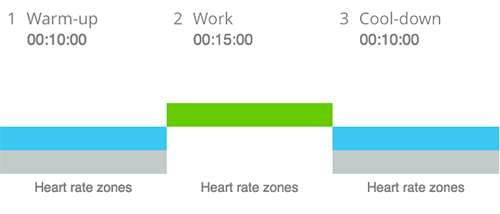
Run 10 minutes at an aerobic pace (zone 2), followed by 15 minutes of zone 3 heart rate, and then 10 minutes in zones 1 or 2.
Week 4
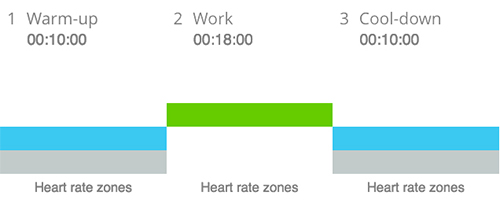
Run 10 minutes at an aerobic pace (zone 2), followed by 18 minutes of zone 3 heart rate, and then 10 minutes in zones 1 or 2.
Week 5
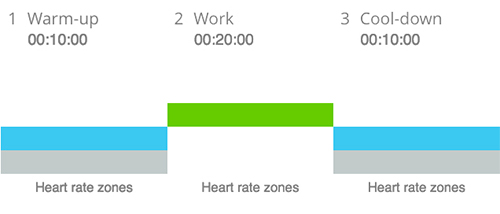
Run 10 minutes at an aerobic pace (zone 2), followed by 20 minutes of zone 3 heart rate, and then 10 minutes in zone 1 or 2.
Week 6

Run 10 minutes at an aerobic pace (zone 2), followed by 2×12 minutes of zone 3 heart rate, with 10 minutes of recovery at zone 2 heart rate in between, and then 10 minutes in zone 1 or 2.
Week 7

Run 10 minutes at an aerobic pace (zone 2), followed by 2×15 minutes of zone 3 heart rate, , with 10 minutes of recovery at zone 2 heart rate in between, and then 10 minutes in zone 1 or 2.
Week 8

Run 10 minutes at an aerobic pace (zone 2), followed by 2×18 minutes of zone 3 heart rate, with 10 minutes of recovery at zone 2 heart rate in between, and then 10 minutes in zone 1 or 2.
Week 9

Run 10 minutes at an aerobic pace (zone 2), followed by 2×20 minutes zone 3 heart rate, with 10 minutes of recovery at zone 2 heart rate in between, and then 10 minutes in zone 1 or 2.
Week 10
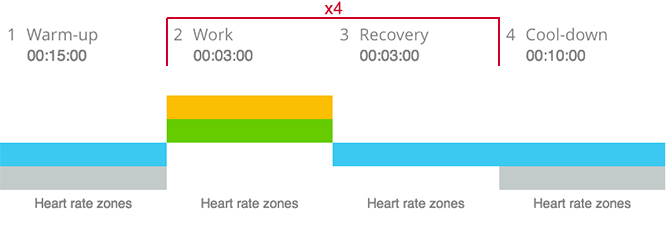
Run 15 minutes at an aerobic pace (zone 2), followed by 3 minutes at zone 4. You’ll follow the 3 minutes hard with 3 minutes easy at zone 2, and you’ll repeat this three more times. In a running sense this will look like 4×3’ (minutes) at LT, with 3’ recovery. Don’t forget to end with 10 minutes at an aerobic pace.
Week 11
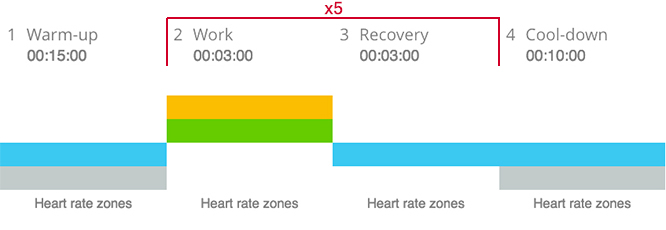
Run 15 minutes of aerobic threshold, followed by 3 minutes at zone 4. Follow the 3 minutes hard with 3 minutes easy at zone 2 and repeat this four more times. In a running sense this will look like 5×3’ at LT, with 3’ recovery. Don’t forget to end with 10 minutes at an aerobic pace.
Week 12
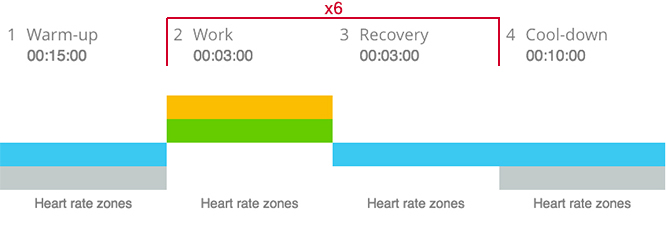
Run 15 minutes of aerobic threshold, followed by 3 minutes at zone 4. Follow the 3 minutes hard with 3 minutes easy at zone 2 and repeat this five more times. In a running sense this will look like 6×3’ at LT, with 3’ recovery. Don’t forget to end with 10 minutes at an aerobic pace.
Interval Training For Experienced Runners: A 12-week Running Workout Plan
For the seasoned runner, the progression would look something like this:
Week 1
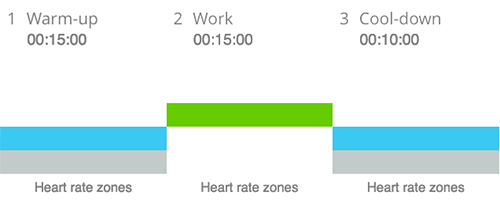
15’ (minute) warm up at zone 2 heart rate, followed by 15’ of tempo running (zone 3), or about -12 beats below your LT from your run test. Finish with 10’ of easy running.
Week 2
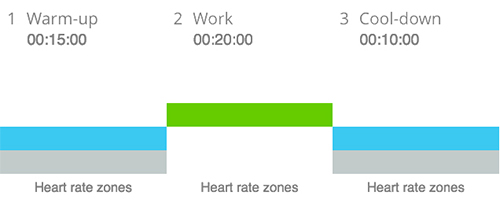
15’ (minute) warm up at zone 2 heart rate, followed by 20’ of tempo running (zone 3). Finish with 10’ of easy running.
Week 3
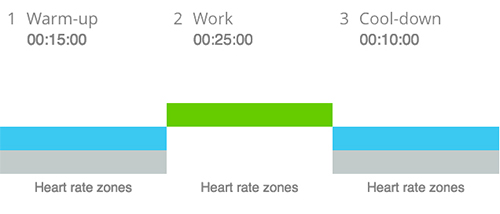
15’ warm up at zone 2 heart rate, followed by 25’ of tempo running (zone 3). Finish with 10’ of easy running.
Week 4
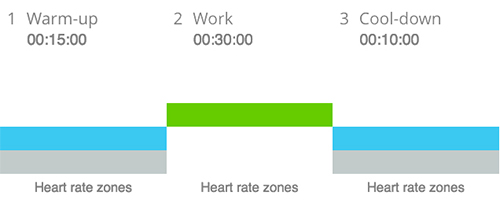
15’ warm up at zone 2 heart rate, followed by 30’ of tempo running (zone 3). Finish with 10’ of easy running.
Week 5
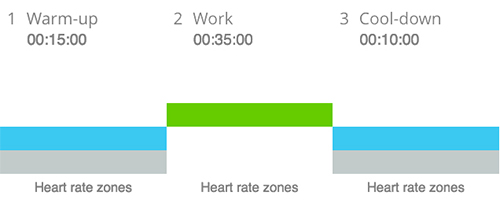
15’ warm up at zone 2 heart rate, followed by 35’ of tempo running (zone 3). Finish with 10’ of easy running.
Week 6
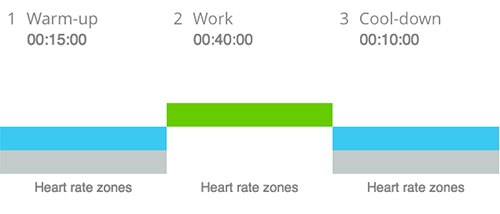
15’ warm up at zone 2 heart rate, followed by 40’ of tempo running (zone 3). Finish with 10’ of easy running.
Week 7
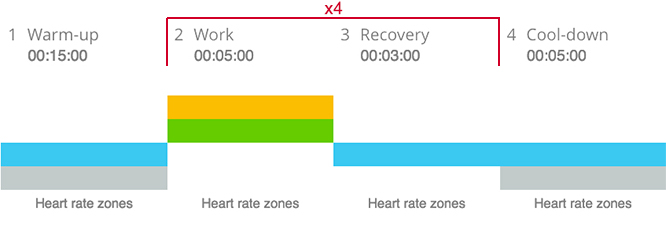
15’ warm up at zone 2 heart rate, followed by 4×5’ of running at zone 4 heart rate or LT, with 3’ recovery at zone 2 heart rate. Finish with 10’ of easy running.
Week 8
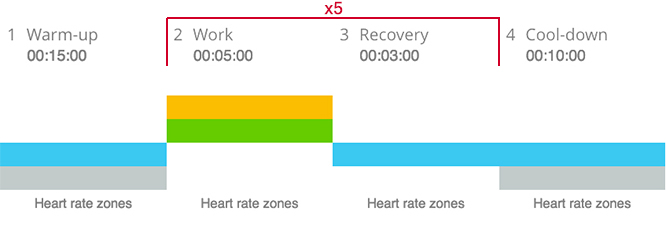
15’ warm up at zone 2 heart rate, followed by 5×5’ of running at zone 4 heart rate or LT, with 3’ recovery at zone 2 heart rate. Finish with 10’ of easy running.
Week 9
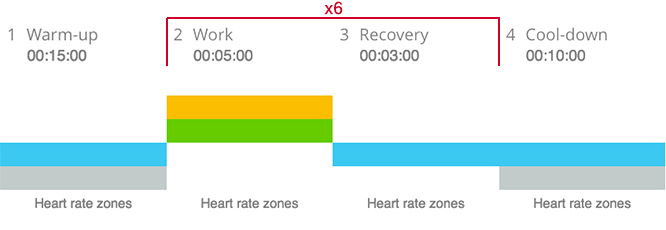
15’ warm up at zone 2 heart rate, followed by 6×5’ of running at zone 4 heart rate or LT, with 3’ recovery at zone 2 heart rate. Finish with 10’ of easy running.
Week 10
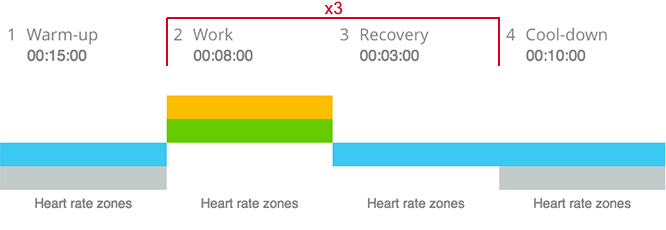
15’ warm up at zone 2 heart rate, followed by 3×8’ of running at zone 4 heart rate or LT, with 3’ recovery at zone 2 heart rate. Finish with 10’ of easy running.
Week 11
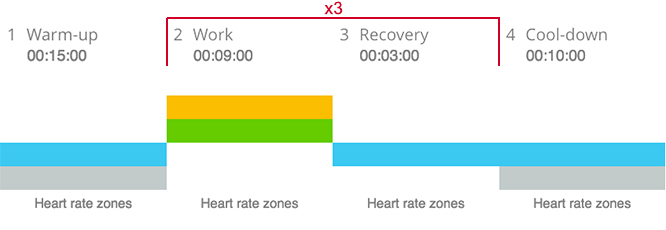
15’ warm up at zone 2 heart rate, followed by 3×9’ of running at zone 4 heart rate or LT, with 3’ recovery at zone 2 heart rate. Finish with 10’ of easy running.
Week 12
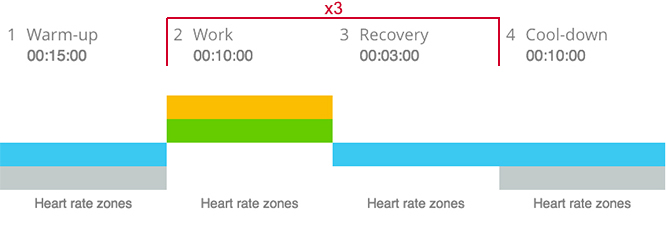
15’ warm up at zone 2 heart rate, followed by 3×10’ of running at zone 4 heart rate or LT, with 3’ recovery at zone 2 heart rate. Finish with 10’ of easy running.
Final words on interval training
It’s important to build your progression at an intensity and volume that you can handle. Use the above interval training plan as a guideline, but be smart and sensitive to how you’re feeling. If you measure your heart rate in the morning and notice it’s higher than usual on the day you’ve planned to do one of these interval workouts, postpone the interval training session and try again once your HR is back to normal.
Hopefully this helps you get started with interval training and improve your running over the next 12 weeks, no matter what level runner you are!
If you liked this post, don’t forget to share so that others can find it, too.
Or give it a thumbs up!
I like this article
Please note that the information provided in the Polar Blog articles cannot replace individual advice from health professionals. Please consult your physician before starting a new fitness program.

